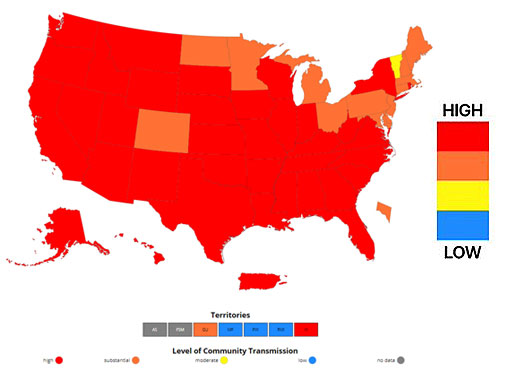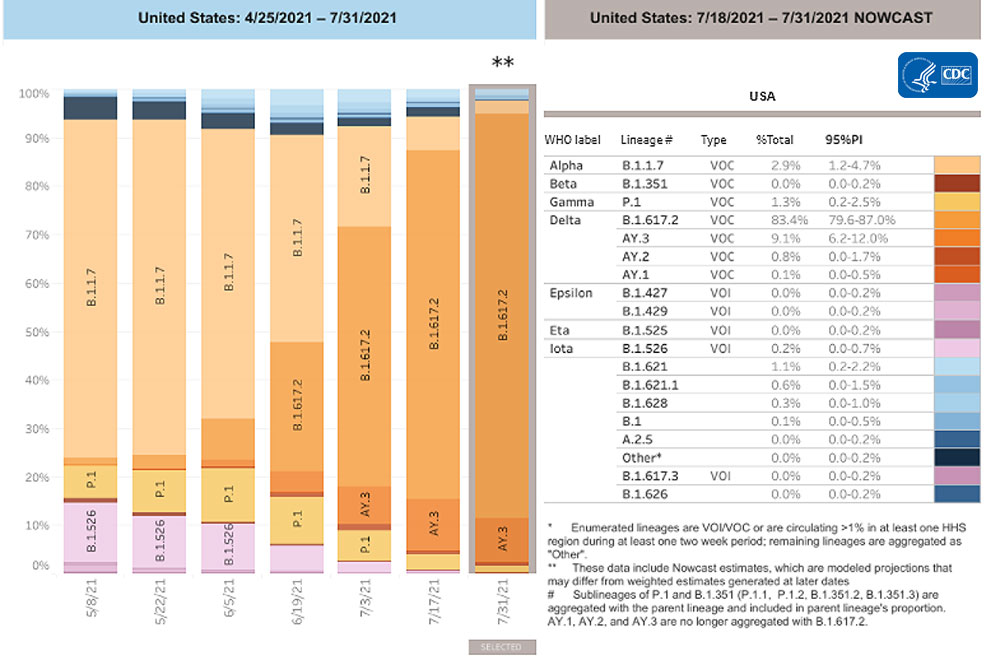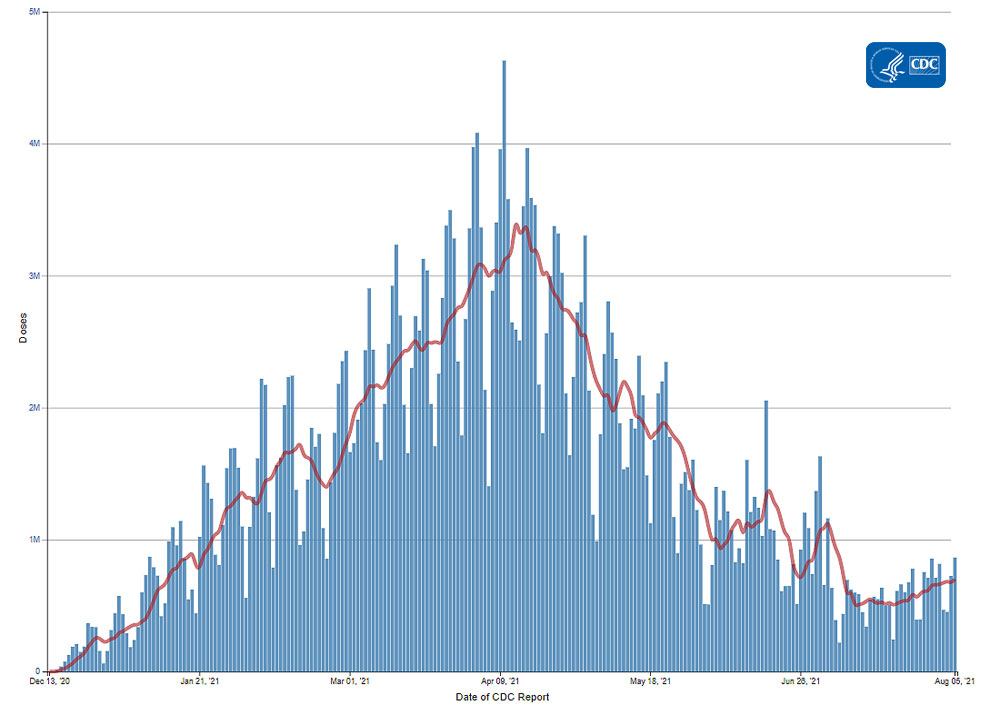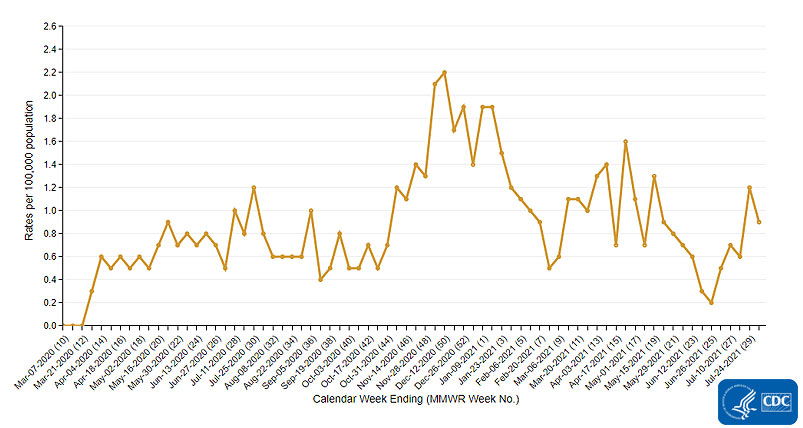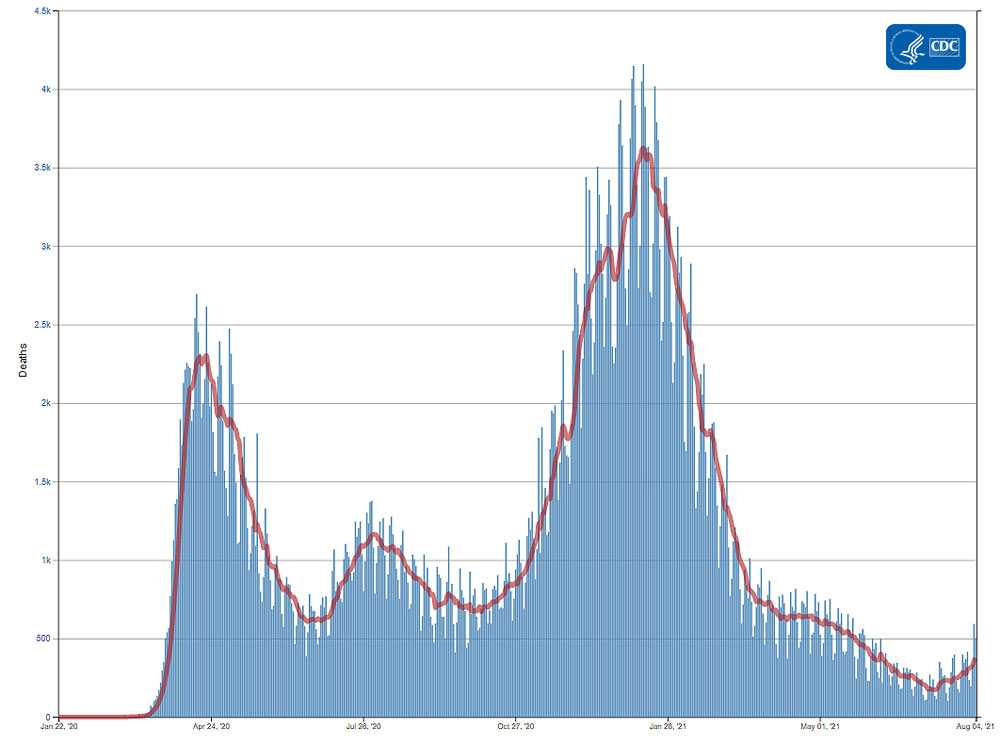Recommendations for Fully Vaccinated People
COVID-19 Homepage

We Were on a Break!
Interpretive Summary for August 6, 2021
We Were on a Break!
Most U.S. states and jurisdictions are experiencing substantial or high levels of community transmission fueled by the spread of the highly contagious B.1.617.2 (Delta) variant. COVID-19 cases, hospitalizations, and deaths continue to increase, especially in communities with lower vaccination coverage. While the number of people getting vaccinated also continues to increase, many people remain unsure about getting vaccinated, and others do not plan to do so.
On July 27, 2021, CDC announced updated Guidance for COVID-19 Prevention Strategies based on emerging evidence of the B.1.617.2 (Delta) variant. CDC recommends that all people, regardless of vaccination status, wear masks in public indoor settings in areas of substantial or high transmission. A new CDC study supports previous findings that B.1.617.2 (Delta) is highly contagious, and is contributing to an increase in cases, including those with severe outcomes and those due to vaccine breakthrough infections. While vaccinated people can still develop COVID-19, they are far less likely to get severely sick or die than people who are unvaccinated.
Vaccination is the best tool we have for protecting ourselves and our loved ones against COVID-19. The COVID-19 vaccines authorized for use in the United States continue to protect against severe illness, hospitalizations, and death. To find a vaccine provider near you, visit Vaccines.gov or your state or local public health department website. If you or someone you know is hesitant about COVID-19 vaccination, CDC has information and answers to frequently asked questions to help make informed decisions.
Note to readers: The latest county-level data for each state (including cases, deaths and level of community transmission) can be downloaded from COVID Data Tracker’s County View page by following the steps below:
- Select your state and county of interest using the dropdowns.
- Scroll down past the maps, figures, and community characteristics table to the county level data tables.
- Click on “County Level Latest Data for [State]” to expand and view the data table.
- Click on the “Download Data” button in the top right to download the csv.
- The downloaded file contains county level data for the selected state. These data include counts, rates, and percent change for cases, deaths, testing, and hospitalizations, as well as level of community transmission, among other metrics.
Reported Cases
The current 7-day moving average of daily new cases (89,977) increased 33.7% compared with the previous 7-day moving average (67,274). The current 7-day moving average is 30.9% higher compared to the peak observed on July 20, 2020 (68,717). The current 7-day moving average is 64.6% lower than the peak observed on January 10, 2021 (254,060) and is 682.9% higher than the lowest value observed on June 19, 2021 (11,493). A total of 35,392,284 COVID-19 cases have been reported as of August 4.
35,392,284
Total Cases Reported
35,392,284
Total Cases Reported
89,977
Current 7-Day Average*
89,977
Current 7-Day Average*
67,274
Prior 7-Day Average
67,274
Prior 7-Day Average
+33.7%
Change in 7-Day Average since Prior Week
+33.7%
Change in 7-Day Average since Prior Week
*Historical cases are excluded from daily new cases and 7-day average calculations until they are incorporated into the dataset for the applicable date. Of 80,589 historical cases reported retroactively, 2,809 were reported in the current week and 2,086 were reported in the prior week.
Daily Trends in COVID-19 Cases in the United States Reported to CDC

7-Day moving average
SARS-CoV-2 Variants
Multiple variants of the virus that causes COVID-19 are circulating globally, including within the United States. Currently, four variants are classified as a variant of concern (VOC). Nowcast estimates* of SARS-CoV-2 cases caused by these VOCs for the two weeks ending July 31 are summarized here. Nationally, the combined proportion of cases attributed to Delta (B.1.617.2, AY.1, AY.2, AY.3) is predicted to increase to 93%; Alpha (B.1.1.7) proportion is predicted to decrease to 2.9%; Gamma (P.1) proportion is predicted to decrease to 1.3%; and Beta (B.1.351) is predicted to be less than 0.1%. Nowcast estimates predict that Delta (B.1.617.2, AY.1, AY.2, and AY.3) will continue to be the predominant lineage circulating in all 10 HHS regions. Alpha (B.1.1.7) is predicted to be less than 7% in all HHS regions. Gamma (P.1) is predicted to be 3.1% or less in all HHS regions; and Beta (B.1.351) is predicted to be less than 0.2% in all HHS regions.
*The median time from specimen collection to sequence data reporting is about 3 weeks. As a result, weighted estimates for the most recent few weeks may be unstable or unavailable. CDC’s Nowcast is a data projection tool that helps fill this gap by generating timely estimates of variant proportions for variants that are circulating in the United States. View Nowcast estimates on CDC’s COVID Data Tracker website Variant Proportions page.
Testing
The percentage of COVID-19 NAATs (nucleic acid amplification tests) that are positive (percent positivityExternal) has increased from the previous week. The 7-day average of percent positivity from tests is now 9.5%. The 7-day average number of tests reported for Jul 23 – Jul 29 was 816,672 up 15.4% from 707,631 for the prior 7 days.
492,285,922
Total Tests Reported
492,285,922
Total Tests Reported
816,672
7-Day Average Tests Reported
816,672
7-Day Average Tests Reported
9.5%
7-Day Average % Positivity
9.5%
7-Day Average % Positivity
8.2%
Previous 7-Day Average % Positivity
8.2%
Previous 7-Day Average % Positivity
+15.7%
Change in 7-Day Average % Positivity since Prior Week
+15.7%
Change in 7-Day Average % Positivity since Prior Week
COVID-19 NAAT Laboratory Test 7-day Percent Positivity by State/Territory
Vaccinations
The U.S. COVID-19 Vaccination Program began December 14, 2020. As of August 5, 348.9 million vaccine doses have been administered. Overall, about 193.2 million people, or 58.2% of the total U.S. population, have received at least one dose of vaccine. About 165.6 million people, or 49.9% of the total U.S. population, have been fully vaccinated.* As of August 5, the 7-day average number of administered vaccine doses reported (by date of CDC report) to CDC per day was 699,261, a 13.63% increase from the previous week.
CDC’s COVID Data Tracker Vaccination Demographic Trends tab shows vaccination trends by age group. As of August 5, 90.2% of people ages 65 or older have received at least one dose of vaccine and 80.3% are fully vaccinated. Over two-thirds (70.4%) of people ages 18 or older have received at least one dose of vaccine and 60.8% are fully vaccinated. For people ages 12 or older, 68.1% have received at least one dose of vaccine and 58.4% are fully vaccinated.
348,966,419
Vaccines Administered
348,966,419
Vaccines Administered
193,199,353
People who received at least one dose
193,199,353
People who received at least one dose
165,637,566
People who are fully vaccinated*
165,637,566
People who are fully vaccinated*
58.2%
Percentage of the US population that has received at least one dose
58.2%
Percentage of the US population that has received at least one dose
49.9%
Percentage of the US population that has been fully vaccinated*
49.9%
Percentage of the US population that has been fully vaccinated*
+1
Percentage point increase from last week
+1
Percentage point increase from last week
+0.5
Percentage point increase from last week
+0.5
Percentage point increase from last week
*People are considered fully vaccinated 2 weeks after their second dose in a 2-dose series (such as the Pfizer or Moderna vaccines), or 2 weeks after a single-dose vaccine (such as Johnson & Johnson’s Janssen vaccine).
Daily Change in the Total Number of Administered Doses Reported to CDC by the date of CDC Report, United States

7-Day moving average
Hospitalizations
New Hospital Admissions
The current 7-day average for July 28–August 3 was 7,707. This is a 40.0% increase from the prior 7-day average (5,506) from July 21–July 27. The 7-day moving average for new admissions has consistently increased since June 25, 2021.
2,436,010
Total New Admissions
2,436,010
Total New Admissions
7,707
Current 7-Day Average
7,707
Current 7-Day Average
5,506
Prior 7-Day Average
5,506
Prior 7-Day Average
+40.0%
Change in 7-Day Average
+40.0%
Change in 7-Day Average
The start of consistent reporting of hospital admissions data was August 1, 2020.
Daily Trends in Number of New COVID-19 Hospital Admissions in the United States
New admissions are pulled from a 10 am EST snapshot of the HHS Unified Hospital Timeseries Dataset. Due to potential reporting delays, data from the most recent 7 days, as noted in the figure above with the grey bar, should be interpreted with caution. Small shifts in historic data may also occur due to changes in the CMS Provider of Services file, which is used to identify the cohort of included hospitals.
COVID-NET: Trends in Hospitalizations in Children Ages 4 Years and Younger
CDC’s Coronavirus Disease 2019-Associated Hospitalization Surveillance Network (COVID-NET) shows that hospitalization rates are increasing, including rates in children. Compared to June 26, 2021, weekly rates in children ages 4 years and younger for the week ending July 17, 2021 have tripled from 0.2 to 0.6 per 100,000 population. While rates are higher in adults, children—including very young children—are also at risk for COVID-19-associated hospitalizations. Unlike adults, children younger than 12 years of age are not yet eligible for any of the available COVID-19 vaccines.
Trends in Hospitalizations in Children Ages 4 Years and Younger
The Coronavirus Disease 2019 (COVID-19)-Associated Hospitalization Surveillance Network (COVID-NET) is an additional source for hospitalization data collected through a network of more than 250 acute-care hospitals in 14 states (representing ~10% of the U.S. population). Detailed data on patient demographics, including race/ethnicity, underlying medical conditions, medical interventions, and clinical outcomes, are standardized case reporting form.
Deaths
The current 7-day moving average of new deaths (377) has increased 34.8% compared with the previous 7-day moving average (280). The current 7-day moving average is 67.6% lower compared to the peak observed on August 1, 2020 (1,164). The current 7-day moving average is 89.6% lower than the peak observed on January 13, 2021 (3,625) and is 116.3% higher than the lowest value observed on July 10, 2021 (174). As of August 4, a total of 612,958 COVID-19 deaths have been reported.
612,958
Total Deaths Reported
612,958
Total Deaths Reported
377
Current 7-Day Average*
377
Current 7-Day Average*
280
Prior 7-Day Average
280
Prior 7-Day Average
+34.8%
Change in 7-Day Average Since Prior Week
+34.8%
Change in 7-Day Average Since Prior Week
*Historical deaths are excluded from the daily new deaths and 7-day average calculations until they are incorporated into the dataset by their applicable date. Of 6,310 historical deaths reported retroactively, 166 were reported in the current week and 26 were reported in the prior week.
Daily Trends in Number of COVID-19 Deaths in the United States Reported to CDC

7-Day moving average
- COVID-19 Vaccine Safety in Adolescents Aged 12–17 Years — United States, December 14, 2020–July 16, 2021
- Outbreak of SARS-CoV-2 Infections, Including COVID-19 Vaccine Breakthrough Infections, Associated with Large Public Gatherings — Barnstable County, Massachusetts, July 2021
- Guidance for Implementing COVID-19 Prevention Strategies in the Context of Varying Community Transmission Levels and Vaccination Coverage
- Rapid Increase in SARS-CoV-2 B.1.617.2 (Delta) Variant Circulation — Mesa County, Colorado, April–June 2021
- Effectiveness of COVID-19 Vaccines in Preventing Hospitalization Among Adults Aged ≥65 Years — 13 states, COVID-NET, February–April 2021
- Reduced Risk of Reinfection with SARS-CoV-2 After COVID-19 Vaccination — Kentucky, May–June 2021
Recent COVID Data Tracker Updates
- The Vaccination Among People with Disabilities tab displays information on the number of vaccinated adults with disabilities in the United States
- 2020 county-level timeseries data are now available on the County View tab, allowing users to examine key COVID-19 metrics across the entirety of the pandemic
